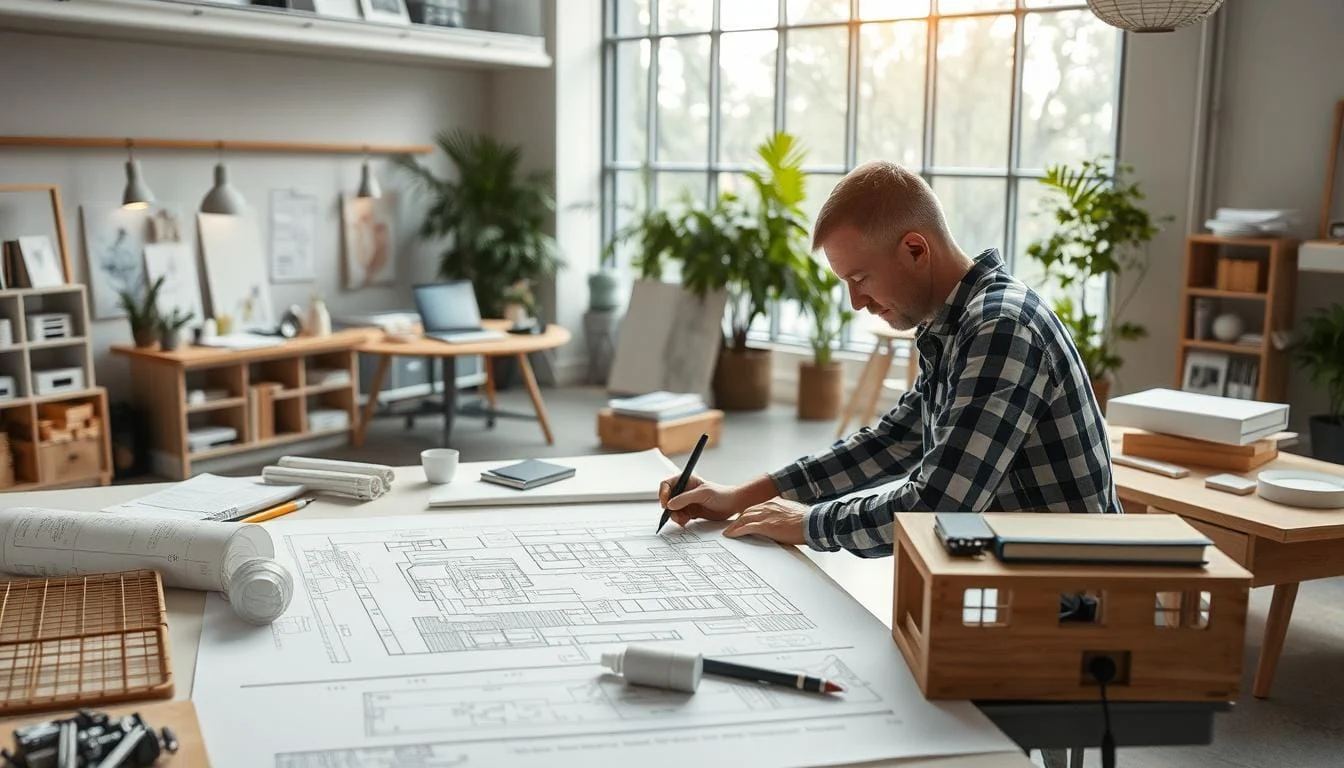Architecture, interior design, and interior architecture shape our living spaces. These fields blend creativity and functionality. Each discipline has unique roles in crafting our built environment.
Architects design building structures. Interior designers bring spaces to life. Interior architecture bridges these two fields. It combines structural knowledge with aesthetic expertise.
Understanding these fields is vital for space transformations. It helps in home renovations and career choices. Knowing the differences aids in making smart decisions.

Each field contributes to creating harmonious environments. Building codes guide architects. Color schemes influence interior designers. Together, they blend creativity with practicality.
These professions shape the spaces we live in. They combine technical skills and artistic vision. Their work impacts our daily lives and experiences.
Need design help? Find skilled freelance designers here to bring your ideas to life.
Key Takeaways
- Architects focus on structural design, while interior designers create atmospheric spaces
- Interior architecture bridges the gap between architecture and interior design
- Architects require extensive technical knowledge and licensing
- Interior designers emphasize aesthetics and human psychology in spaces
- Education paths differ, with architecture requiring longer, more technical programs
- Both fields use CAD software but for different aspects of design
- Understanding these differences helps in choosing the right professional for your project
What is Architecture Interior Design: Core Concepts and Definitions
Architecture interior design combines structural elements with aesthetic focus. This field has grown rapidly in recent years. Many countries now legally recognize Interior Architects.
Understanding the Design Field Spectrum
The design field covers various disciplines with unique focuses. Interior architecture redesigns existing spaces, considering function and history. Interior design creates ambiance through finishes, furniture, and color palettes.
The Evolution of Interior Architecture
Interior architecture now focuses on adaptive reuse and sustainable remodeling. Professionals work on public projects like hospitals and schools. They collaborate with specialists to meet community needs.
Key Elements That Define Each Discipline
Interior architecture and design require similar skills but apply them differently. Interior architects focus on structural design and adaptive reuse. Interior designers create functional and appealing spaces.
| Interior Architecture | Interior Design |
|---|---|
| Structural redesign | Aesthetic focus |
| Adaptive reuse | Furniture selection |
| Collaboration with engineers | Color theory application |
| Problem-solving skills | Client interaction |
Both disciplines transform living spaces creatively. Need help with your next project? Check out freelance platforms for skilled professionals.
The Fundamental Role of Architects in Building Design
Architects shape our built environment in crucial ways. They create designs that balance beauty and practicality. Their work spans from initial concepts to final construction execution.
Structural Planning and Engineering Aspects
Architects team up with engineers to develop sound structural elements. They consider load-bearing abilities, material strengths, and environmental factors. This teamwork ensures buildings are safe, long-lasting, and efficient.

Building Code Compliance and Safety Regulations
Safety takes top priority in architecture. Architects must follow strict building codes and safety rules. They make sure designs meet or exceed standards for fire safety and accessibility.
Exterior Design and Material Selection
A building’s exterior is its public face. Architects choose materials that look good and last long. They think about energy efficiency and how the building fits its surroundings.
| Aspect | Architect’s Role |
|---|---|
| Structural Planning | Collaborate with engineers, design load-bearing elements |
| Code Compliance | Ensure adherence to safety regulations and building codes |
| Material Selection | Choose appropriate building materials for durability and aesthetics |
| Exterior Design | Create visually appealing and functional building exteriors |
Need help with your building project? Hire skilled architects on Fiverr. They’ll bring your vision to life while meeting all technical requirements.
Interior Design: Creating Aesthetic and Functional Spaces
Interior design turns spaces into beautiful, functional havens. Designers craft environments that reflect your personality and meet your needs. Their expertise goes beyond mere decorative elements.

Professionals excel in selecting furnishings, textiles, and color palettes. They consider lighting, layout, and overall aesthetic appeal. Every element contributes to the room’s overall look.
Interior designers work on various projects:
- Residential homes
- Commercial offices
- Hospitality venues
- Exhibition spaces
They team up with clients, brands, and contractors. Their goal is to meet project briefs and budgets. They balance technical design with decorative touches.
“Interior design is about creating atmospheres that capture the essence of the client’s desires.”
Skilled designers bring creativity and practical knowledge to every project. They know how to maximize space and use sustainable materials. Their designs promote wellbeing in the environment.
Want to transform your space? Hire a talented interior designer today. They’ll bring your vision to life with style and expertise.
Interior Architecture: Bridging Design and Structure
Interior architecture blends design with structure, focusing on transforming existing interiors. It considers technical aspects and is crucial for adaptive reuse projects. This field breathes new life into old spaces.
Adaptive Reuse and Space Transformation
Interior architects reimagine existing spaces for new purposes. They analyze areas and create layouts that maximize functionality and flow. Their skills shine when converting offices to apartments or repurposing industrial spaces.

Technical Considerations in Interior Architecture
Interior architects tackle complex technical challenges. They design structural elements while ensuring compliance with building codes. Their expertise covers plumbing, ventilation, and electrical systems.
Sustainable Design Approaches
Sustainability is key in interior architecture. Professionals use energy-efficient materials and technologies to create eco-friendly environments. They focus on natural lighting, ventilation, and recycled materials to reduce ecological impact.
| Aspect | Interior Architecture | Interior Design |
|---|---|---|
| Focus | Structural elements and space planning | Aesthetics and furnishings |
| Education | Architectural degree or specialized master’s | Design diploma or arts background |
| Technical Skills | Building systems, codes, and structural design | Color theory and styling |
| Project Involvement | Early stages, guiding structural decisions | Later stages, focusing on finishes |
Ready to transform your space? Hire a skilled interior architect to bring your vision to life. They’ll craft innovative solutions tailored to your needs.
Educational Requirements and Professional Pathways
Choosing a design career requires careful thought about education. Understanding the requirements for architecture, interior design, or interior architecture is vital. Each path offers unique opportunities and challenges.
Architecture Degree Programs
Becoming an architect requires an architecture degree. This usually means a 5-year undergraduate program or a 2-3 year master’s degree. Some states offer alternative paths through apprenticeships.
Interior Design Certification
Interior designers typically need an associate or bachelor’s degree. Programs cover residential, office, and retail design. A strong portfolio is crucial for showcasing skills and attracting clients.

Interior Architecture Specialization
Interior architecture programs focus on adaptive reuse and structural design principles. This field bridges architecture and interior design. It offers unique career opportunities for those interested in both areas.
| Degree | Duration | Focus Areas |
|---|---|---|
| Architecture | 5 years (undergraduate) | Structural planning, building codes |
| Interior Design | 2-4 years | Space planning, aesthetics |
| Interior Architecture | 3-4 years | Adaptive reuse, structural design |
Excited to start your design journey? Hire a freelance designer for inspiration. Learn from industry pros and kickstart your career in design.
Skills and Competencies: A Comparative Analysis
Architects and interior designers need diverse skills to excel in their fields. While some skills overlap, each profession requires unique abilities. They create functional and beautiful spaces using different approaches.

Architects focus on structural integrity and exterior design. They need expertise in engineering principles and building codes. Architects must visualize large-scale projects and understand how buildings interact with surroundings.
Interior designers have a keen eye for color theory and furniture selection. They balance functionality with style in their designs. These professionals often draw inspiration from various design periods.
Both professions rely heavily on computer-aided design tools. These programs help create detailed plans and 3D renderings. Proficiency in these tools is crucial for success.
| Skill | Architects | Interior Designers |
|---|---|---|
| Structural Planning | Essential | Basic understanding |
| Color Theory | Important | Critical |
| Computer-Aided Design | Extensive use | Extensive use |
| Building Codes | Extensive knowledge | Working knowledge |
| Furniture Selection | Basic understanding | Expert level |
Creative problem-solving is vital for both architects and interior designers. They find innovative solutions to meet client needs. This skill helps them work within budget constraints and follow regulations.
Looking for the right professional for your project? Explore freelance platforms for skilled experts. Hire your freelance architect or interior designer today and watch your vision come to life.
Project Scope and Professional Responsibilities
Design projects involve various professionals with different roles. Architects and interior designers each bring unique skills to bring a project to life.
Architectural Project Management
Architects handle a wide range of tasks in a project. They ensure structural integrity, building code compliance, and manage large-scale construction aspects.
In a 550 square meter project with a 7-month timeline, an architect might coordinate 12 pre-construction meetings. These meetings help align all stakeholders involved.

Interior Design Project Execution
Interior designers focus on functionality and aesthetics when designing interiors. They plan spaces, choose materials, and select decorative elements.
For a project with multiple rooms, designers create cohesive designs for each space. They ensure all areas work together harmoniously, from living rooms to bedrooms.
Collaborative Workflow Processes
Architects and interior designers often work together on complex projects. They might collaborate on additional rooms like home offices or laundry areas.
This teamwork ensures that structural elements and interior design integrate seamlessly. It creates a cohesive and functional space for the client.
| Professional | Primary Focus | Key Responsibilities |
|---|---|---|
| Architect | Overall structure and compliance | Structural planning, code compliance, exterior design |
| Interior Designer | Interior aesthetics and functionality | Space planning, material selection, decorative elements |
| Interior Architect | Blending structure and interior design | Adaptive reuse, space transformation, technical considerations |
Clear communication and defined roles are crucial for project success. Thorough planning helps avoid extra costs, like $150 hourly rates for additional site visits.
Hire a skilled professional to manage these complex responsibilities effectively. They’ll ensure your project runs smoothly from start to finish.
Technology and Tools in Modern Design Practice
The design world has gone digital, changing how professionals work. Building information modeling, computer-aided design, and digital architecture are now vital tools. These technologies have revolutionized the design process.
Digital tools boost efficiency and precision in architectural projects. Building information modeling creates detailed 3D models, improving teamwork and reducing mistakes. Computer-aided design software helps architects craft complex designs easily.
Digital architecture platforms offer virtual walkthroughs for clients. This feature enhances the client experience and helps them visualize the final product.

Interior designers use virtual resource libraries and 3D rendering tools. These advancements streamline the design process and create lifelike visualizations. Smart home technologies are now crucial in interior design.
Designers must seamlessly integrate these technologies into modern spaces. This integration enhances the functionality and appeal of the designed areas.
| Technology | Application | Benefits |
|---|---|---|
| Building Information Modeling (BIM) | 3D modeling and collaboration | Improved efficiency, reduced errors |
| Virtual Reality (VR) | Immersive client presentations | Enhanced visualization, better decision-making |
| 3D Printing | Rapid prototyping | Accurate physical models, faster iterations |
These tech advances improve design processes and create sustainable, energy-efficient buildings. Staying up-to-date with these tools is key for success in the field.
Want to use cutting-edge tech for your design vision? Hire a skilled freelancer to use these innovative tools for your project.
Client Relations and Business Aspects
Managing client relationships is vital in design and construction. Interior designers must balance client needs with practical constraints. They also oversee project budgeting and timelines.
Project Budgeting and Cost Management
Effective project budgeting is key to success in architecture and interior design. Professionals must plan expenses carefully, including materials, labor, and unexpected costs. A well-managed budget ensures client satisfaction and project success.
| Project Size | Typical Budget Range | Duration |
|---|---|---|
| Small Residential | $10,000 – $50,000 | 2-4 months |
| Medium Commercial | $50,000 – $250,000 | 4-8 months |
| Large Luxury Residential | $250,000 – $1,000,000+ | 8-18 months |
Communication with Stakeholders
Clear communication is essential in design projects. Professionals must discuss details with clients to understand their needs and preferences. This includes presenting concepts, addressing concerns, and managing expectations throughout the project.
Contract Administration
Proper contract administration is crucial in design and construction projects. It involves preparing architectural drawings and managing material orders. Overseeing installations is also part of the process.
Successful professionals build trust with clients, contractors, and vendors. This ensures smooth project execution and client satisfaction.
Need help with your design project? Hire skilled interior designers on Fiverr to bring your vision to life.
Conclusion
Architecture, interior design, and interior architecture each play unique roles in shaping our built environment. Architecture focuses on structural integrity and overall design. Interior design brings spaces to life through aesthetics and functionality. Interior architecture bridges these disciplines, addressing both structural and decorative elements.
Architects and interior designers often work together to create cohesive spaces. They develop a consistent design language throughout a project. This teamwork results in seamless integration of interior spaces with architectural design.
New technologies are changing how design ideas are shown and shared. Virtual and augmented reality tools help professionals communicate better with clients. These advancements lead to improved outcomes in both architecture and interior design projects.
Understanding these fields is key for anyone interested in design or building projects. For expert help with your design needs, check out skilled professionals on Fiverr. They can turn your ideas into reality.
FAQ:
For “Architecture vs Interior Design: Understanding Interior Architecture Differences”
Q: What’s the difference between interior architecture and interior design?
A: Interior architecture focuses more on the structural aspects and functionality of interior spaces, while interior design primarily deals with aesthetics and decorative elements. Interior architecture often involves more technical knowledge of building systems and may require a degree in architecture, whereas interior design concentrates on creating aesthetically pleasing and functional living spaces.
Q: How do the roles of architects and interior designers differ?
A: Architects typically focus on the overall structure of a building, including its exterior design and structural integrity. Interior designers, on the other hand, specialize in creating functional and visually appealing interior spaces. While there can be overlap, architects generally have more technical expertise in building systems and construction, while interior designers excel in spatial planning, color theory, and material selection for interiors.
Q: What education is required to become an interior architect vs an interior designer?
A: To become an interior architect, one typically needs a professional degree in architecture, which usually takes 5-7 years to complete. Interior designers, however, can often enter the field with a bachelor’s degree in interior design, which typically takes 4 years. Both professions may require additional licensing or certification, depending on the location and specific job requirements.
Q: Do interior designers need to understand architectural principles?
A: While interior designers don’t need the same level of architectural knowledge as architects, they do benefit from understanding basic architectural principles. This includes knowledge of spatial relationships, building codes, and structural considerations. Understanding these concepts helps interior designers create functional and safe spaces that work harmoniously with the building’s architecture.
Q: What are the main differences between architecture and interior design in terms of project scope?
A: Architecture typically involves the entire building design, from the exterior to the interior structure, including systems like plumbing and electrical. Interior design focuses primarily on the interior spaces, including layout, furnishings, color schemes, and decorative elements. While architects may work on large-scale projects like designing entire buildings, interior designers often work on specific rooms or spaces within existing structures.
Q: How do interior architects differ from interior decorators?
A: Interior architects have more extensive training in the technical aspects of building design and construction, often holding a degree in architecture. They focus on the structure and functionality of interior spaces. Interior decorators, however, primarily deal with the aesthetic aspects of a space, such as selecting furnishings, colors, and accessories. Interior designers fall somewhere between these two, combining elements of both roles.
Q: Can interior designers and interior architects collaborate on projects?
A: Yes, interior designers and interior architects often collaborate on projects, especially for large-scale or complex designs. Their complementary skills can create a more comprehensive approach to interior spaces. Interior architects may focus on the structural and functional aspects, while interior designers contribute their expertise in aesthetics and creating a cohesive look and function for the space.
Q: What skills do interior architects need that interior designers may not?
A: Interior architects typically need more advanced technical skills related to building systems, structural design, and construction methods. They often require proficiency in specialized architectural software and a deeper understanding of building codes and regulations. Interior architects may also need more extensive knowledge of materials science and environmental systems compared to interior designers.
Source Links
- Interior environment involves complex interactions between interior design vs traditional approaches.
- Interior decoration focuses on aesthetic elements while creating interior spaces.
- The difference between interior design and interior architecture
- Interior designer’s work at a construction site involves the design of an interior that considers both form and function.
- Architecture focuses on the functionality of spaces, while interior designers also develop interior spaces and develop comprehensive solutions for the interior of a building.
- Interior designers design the interiors by analyzing aspects of the design and designing interior spaces to enhance the look and utility of environments.
- A program in interior requires understanding that architecture is the design of spaces.
- Practice architecture involves the work of an architect as well as interior specialists.
- Art of design encompasses various design styles and design places.
- Many interior designers use the title of interior architects who oversee design spaces and design plans for existing interior structure.
- Consider interior aspects like landscape architecture and environmental architecture.
- senior interior designer needs architect registration as a licensed architect, typically studying a bachelor degree where an architect is trained.
- An architect involves comprehensive spatial understanding beyond mere decoration.
- Interior architecture vs traditional design approaches explores spatial relationships.
- Interior architects oversee complex design processes, considering whether interior configurations meet functional and aesthetic requirements.
- Interior design and architecture are complementary disciplines that focus on creating functional and aesthetically pleasing spaces.
Related Articles:
- How Much Do You Pay a Book Illustrator for Children’s Book Illustrations?
- Custom Caricature Portraits – Unique Caricature Drawings and Cartoon Portraits
- 10 Best Freelance Cartoonists for Hire: Top Comic Artists & Illustrators in 2025
- Mastering Patterns in Graphic Design: Essential Techniques for Your Design Project
- How to Choose a Tattoo Design: Tips from The Best Tattoo Artists
- What is Storyboard and Why is it Important? | Using Storyboards for Filmmaking
- Create NFT Art: A Step-by-Step Guide to Make Your Own NFT Token
Our Partners: CSKDesignCrafts.com – FitFusioHub.com – LifeCraftsCentre.com
This post contains affiliate links, which means I may earn a commission if you make a purchase through these links. There is no additional charge to you! Thank you for supporting my blog so I can continue creating free content each week!




